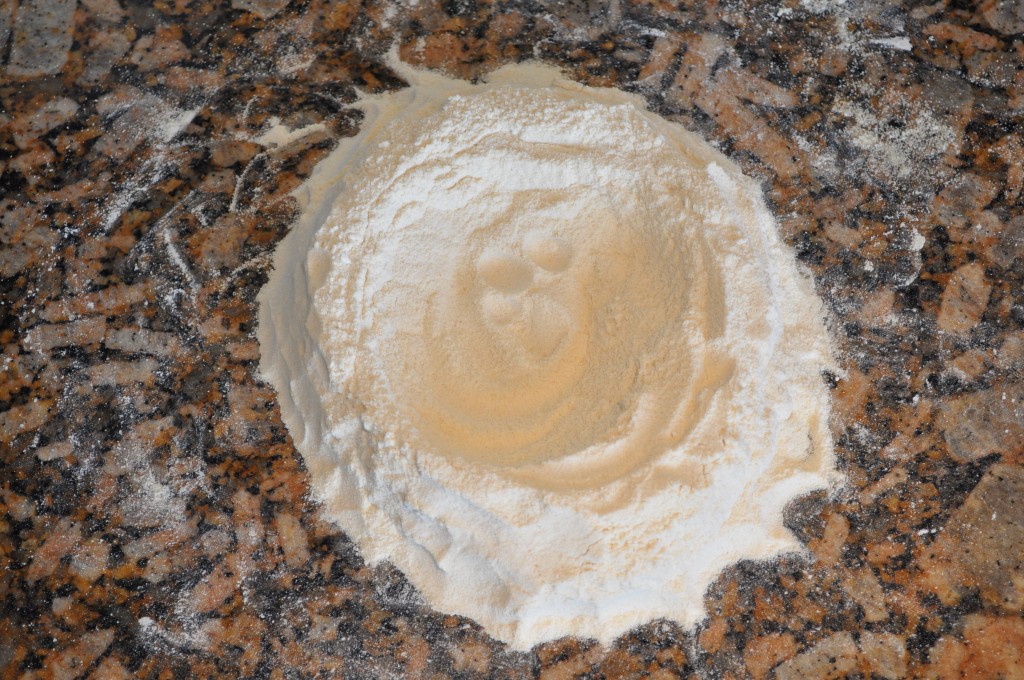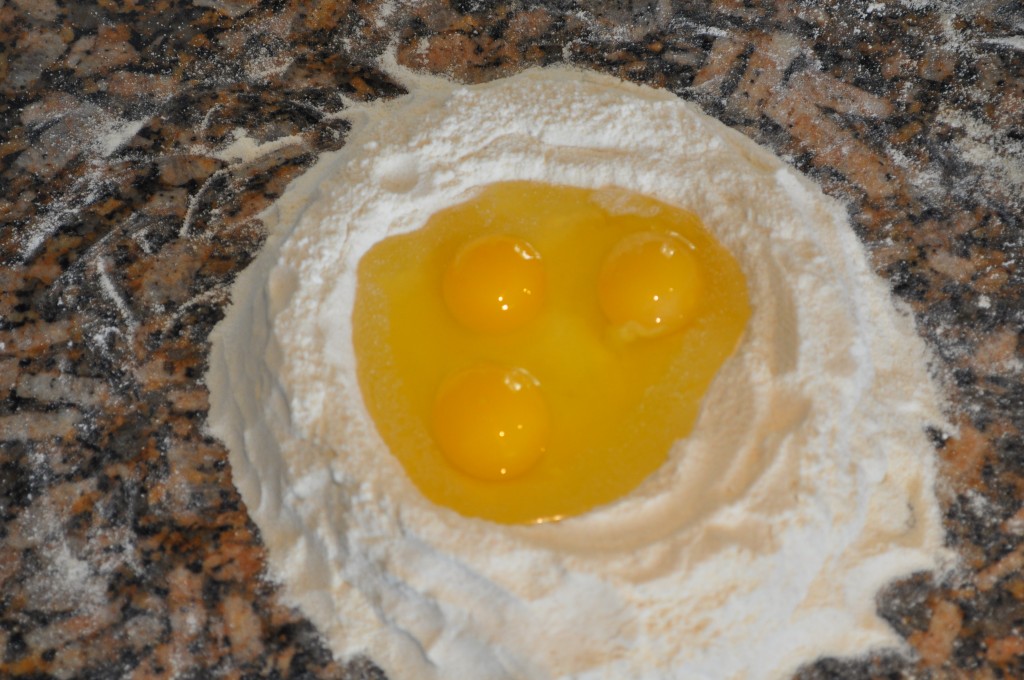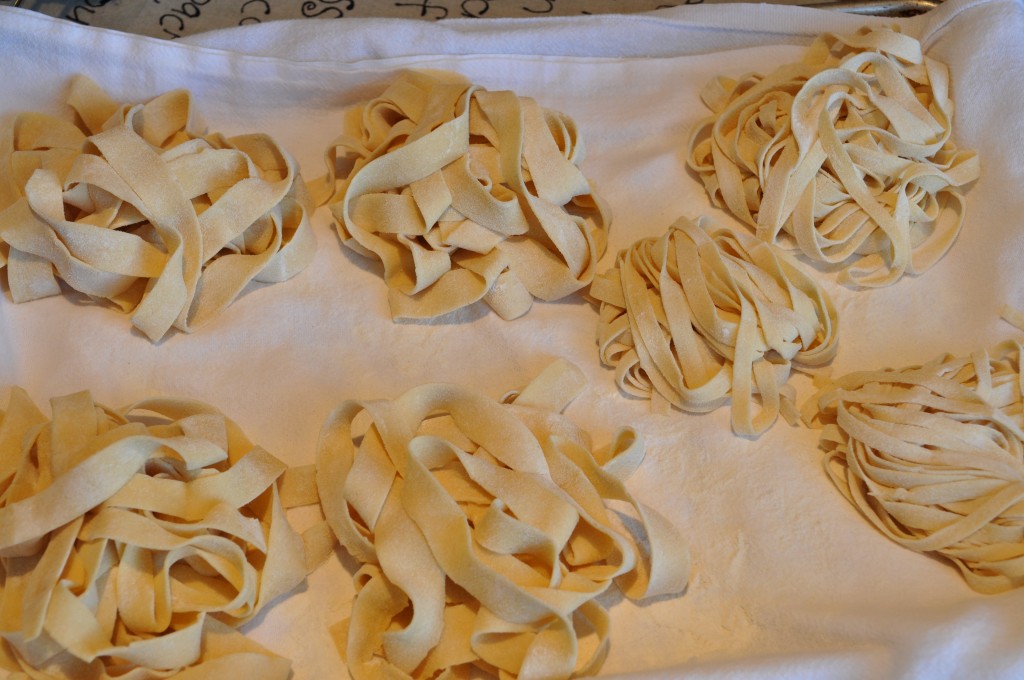
Most Italians call fresh pasta “Homemades”. Yep, that was the word Mom used to let us know we were going to have fresh pasta for Sunday Dinner. (I know I have told you in the past the story of my Mother making homemades.) I have been making fresh pasta for years and I am always upgrading my recipe. Recently I gave my brother Vince and sister-in-law Kathy a lesson in making fresh pasta. My sister was taking part in the lesson too since she is an accomplished pasta chef as well. I used my Mothers recipe which is one cup of all purpose flour to one whole large egg. This is the only recipe my Mother used but I, always being the one to experiment, changed my recipe to include Semolina Flour.
Today I made my “Homemades” with half Double Zero Flour and half Semolina Flour. The result was a much more tender and tastier pasta. I rolled it out a little thicker than usual and it was the best I have ever made. A little thicker made it more “toothsome” giving me the feel in my mouth that I so enjoy about pasta. Something I can’t explain but there were a lot of ow’s and ah’s at the dinner table. I even think I heard a little bit of food humming going on that night. You know what I’m talking about you lover of pasta!!
Here is my newest recipe for Fresh Pasta – “Homemades” Italian style.
Homemade Pasta with Double Zero and Semolina Flour
You can count on one egg per person when making pasta. I usually do 3 eggs because it is a workable amount: I have enough for dinner and I freeze whatever I don’t use for a later date. If I do too many eggs at one time I will end up with too much dough to roll and I get bored and tired of rolling after a while.
1½ Cups Double Zero Flour, Plus More for Rolling Out
1½ Cups Semolina Flour
3 Whole Large Eggs
½ Teaspoon Fine Sea Salt
½ Cup Water, Room Temperature

In a bowl combine the two flours and the salt with a whisk. Place the flour mixture directly on a work surface and make a well (hole) in the flour leaving some at the bottom of the well.

Break the eggs into the middle of the well. With a fork gently incorporate the eggs into the flour by taking a bit of the flour from the inside sides of the well being careful not to break the walls of the well. If this happens the eggs will escape from the well and run all over your work surface. Once the eggs are incorporated enough to not run finish incorporating the flour and eggs with your hands. To help pull the dough together, wet your hands every now and then with the room temperature water. The reason for this is to keep out as much excess water as possible. (Sometimes I use all of the water and sometimes I don’t; it all depends on the atmosphere of the day. Just don’t use any more than ½ cup.) Once it is completely incorporated scrape any hard bits off the work surface, lightly flour it and begin kneading the dough. Constantly turn the dough over itself and by using the heel of your hand push it away from you. Do this for about 10 minutes to create a soft, pliable dough. The dough should be soft, not sticky, and not hard.

Shape the dough into a ball and place it on a lightly floured tea towel and cover with a bowl. Let the dough rest for 1 hour before rolling out.
After an hour, cut the dough into half and each half into thirds. While working with a piece of dough keep the others covered with the bowl. Roll the first piece with a rolling pin to about ½ inch thick. This will help the dough go through the rollers of the machine easily and not squeeze out the moisture you want. Set your machine on the highest number and roll the dough through 6 to 8 times folding it over itself each time. Turn the number to the next lowest and roll the dough through 4 times folding the dough over itself each time. Continue lowering the numbers and rolling the dough 3 or 4 times through each number until you reach the thickness you like. Once the dough has gone through all of the settings cut into noodles to the thickness you like by hand. (I have 8 settings on my machine with 8 being the thickest. I roll my thicker pasta through #4 setting and thinner through #3. I roll ravioli sheets through #2 setting. My brother’s pasta machine works the opposite with having #1 as the thickest. Use your own taste as to how thick you want your pasta, but I am guessing that if you already have a pasta machine you know what thickness suites you best.)

Place the pasta on a lightly floured towel on a sheet pan into nests. Continue with each piece of dough until all is rolled and cut. Remember to do each piece individually. Rolling all of the pieces first and then cutting them does not work. The dough begins to dry and will not cut without cracking.
Hints and Tips: Folding the dough over itself and rolling over and over makes for a perfectly elastic dough that will not fall apart when you cook the pasta.
If the dough starts to get sticky when rolling it out don’t be afraid to sprinkle a little flour on it. When you fold it over itself while rolling don’t put extra flour on the sides that will meet each other.
When you put the cut pasta on the floured towel in nests let it air dry without covering it. After a bit, gently lift the nests to be sure they are not sticking to each other.
Cooking the pasta should be done in a large pot with lots of boiling, salted water. The pasta will take only a few minutes to cook as opposed to the longer cooking time for dried pasta.
This pasta freezes well. I IQF (Individually Quickly Freeze) the nests and then place them in a large plastic container or plastic bag. It will last in the freezer for a month.
Let me know your results.
camille@camillecooksforyou.com
